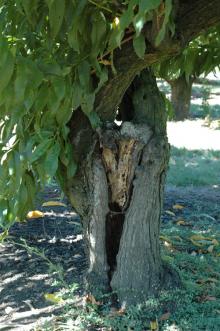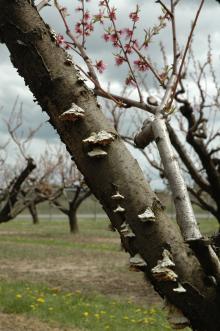Cause Most fungi that cause extensive wood decay of stone fruit trees are classified in the phylum Basidiomycota. These fungi produce various basidiocarps, such as mushrooms and conks, containing basidia. Basidiospores are forcibly discharged from basidia and usually are disseminated by air currents. Wood decay fungi enter trees primarily through wounds that expose sapwood or heartwood. Injuries from pruning, sunburn, lightning, or cultivating equipment can expose susceptible wood. Large wounds and stub and horizontal cuts are often entry sites for decay fungi. Mycelial growth of the fungus proceeds with colonization and utilization of wood as a food source. Basidiocarps develop after extensive colonization of the substrate in a suitable environment and under suitable physiological conditions. Asexual spores are not commonly produced.
Wood decay is generally observed in older trees after extensive fungal colonization, but it also occurs in young trees. Decay fungi frequently function as secondary invaders following a succession of microorganisms, including bacteria, yeasts, and other fungi. Decay in a single tree may be caused by more than one fungal species. Live trees are able to limit wood decay by walling off and compartmentalizing decay fungi but this can vary between different species and individuals. The CODIT model/principle (compartmentalization of decay in trees) is used by certified arborists to manage landscape trees with decay.
Symptoms Two types of wood decay occur in living trees: white rots and brown rots. White rots cause moist, soft, or spongy wood that is of a lighter color that sound wood. All major structural components of the cell wall-cellulose, hemicellulose, and lignin-are degraded. The strength of white rotted wood decreases only in advanced stages of decay.
Brown rots of wood are brown, dry, and crumbly, with longitudinal and transverse cracks. Most of the cell wall polysaccharides are degraded, but the lignin component is unchanged or slightly modified. The strength of brown rotted wood is significantly reduced or lost entirely shortly after decay is initiated. These rots usually occur in exposed wood and can cause extensive damage, resulting in structural failure.
Wood decay leads to limb breakage, uprooted trees, trees broken at the soil line during windstorms or decreased tree vigor, and dieback.
Cultural control
- Help prevent wood decay by using cultural practices that promote tree growth and vigor while minimizing injuries that expose wood.
- Irrigation water, especially from sprinklers, should not wet the trunks.
- Cultivation and mowing equipment should not injure the roots, crown, or lower trunk.
- Make pruning cuts adjacent to, but not into, the supporting branch; prune when the branches are small, to enhance callus formation and wound healing.
- Tree paints for protecting wounds must provide complete coverage and maintain an intact layer to be useful. Sealants often crack and expose unprotected wood to decay fungi.
Reference Adaskaveg, J.E. and Ogawa, J.M. 1990. Wood decay pathology of fruit and nut trees in California. Plant Disease 74:341-352.



